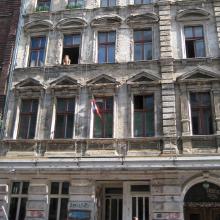KuLe
The KuLe Kunsthaus (art house) is a non-profit association housing artists, studios, exhibition spaces and cultural programming in Mitte. KuLe stands for Kunst und Leben, or Art and Life. The KuLe combines residential and workspaces, and the art and cultural practices housed there are multidisciplinary, international, and experimental. It began in 1990 as a squat on Auguststraße 10, with the utopian idea to bring art and life together.
The Auguststraße would go on to be one of the most gentrified streets in the district, famous for its line-up of mainstream art galleries. The KuLe remains as a counterpoint to this context, with its alternative mission and ruinous façade. In 1993, when many buildings in the area began to be sold to private developers and turned into commercial enterprises, the KuLe was purchased by two landlords with a different mindset. Described as “art lovers,” they partnered with the KuLe occupants and with the government to renovate the building and keep the KuLe project there.
Between 1995 and 1998, members of the KuLe—supported by funds from the government—worked on the building cooperatively, carrying out necessary maintenance and repair works. But they obstinately kept the façade in its decrepit state: “Rather than ‘smoothing out’ traces of contemporary history through a rehabilitative makeover, the building’s extensive restoration … allowed those traces to remain visible.” This was possible thanks to a transparent veneer that seals the façade against further decay, corrosion, erosion, or infiltrations, but which is invisible to the naked eye (it would not have been possible to leave the decayed façade untouched, as it would have posed a safety risk for the building and for passersby).
The significance of the counterpreserved KuLe façade as a proclamation of utopian difference in the cityscape is magnified by the curatorial decision to use the façade as a vertical gallery, a space of exhibition for projects from KuLe members and guest artists from Berlin and beyond. The façade opens up the KuLe to the public sphere as a realm of dialogue and exhibition, eloquent not only when projects are mounted on it, but also when they are not, letting the variegated texture of the weathered façade speak for itself in contrast with its renovated surroundings.
